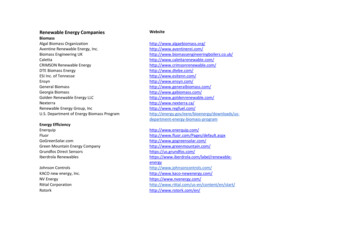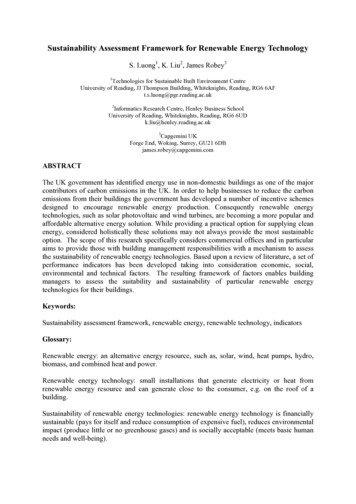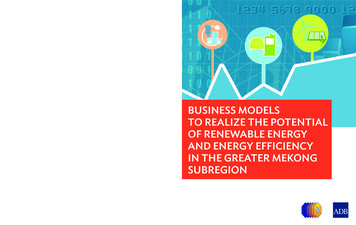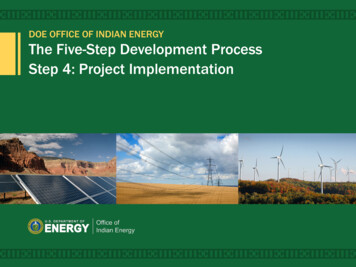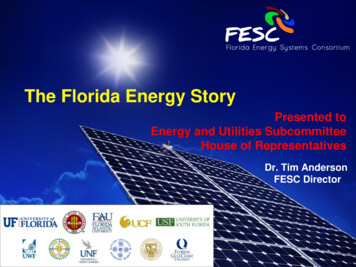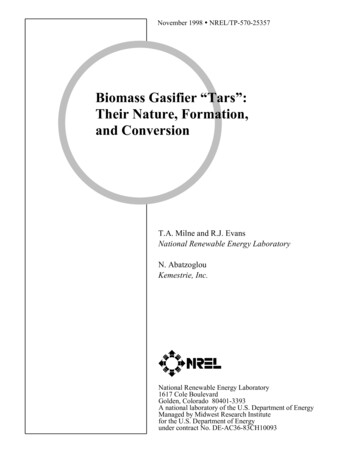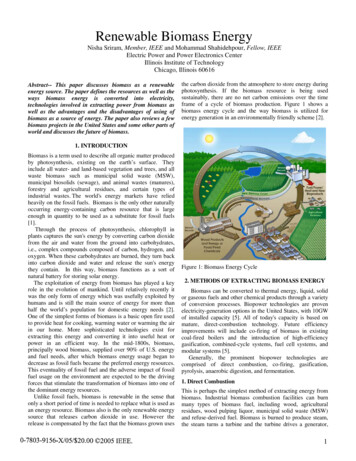
Transcription
Renewable Biomass EnergyNisha Sriram, Member, IEEE and Mohammad Shahidehpour, Fellow, IEEEElectric Power and Power Electronics CenterIllinois Institute of TechnologyChicago, Illinois 60616Abstract-- This paper discusses biomass as a renewableenergy source. The paper defines the resources as well as theways biomass energy is converted into electricity,technologies involved in extracting power from biomass aswell as the advantages and the disadvantages of using ofbiomass as a source of energy. The paper also reviews a fewbiomass projects in the United States and some other parts ofworld and discusses the future of biomass.the carbon dioxide from the atmosphere to store energy duringphotosynthesis. If the biomass resource is being usedsustainably, there are no net carbon emissions over the timeframe of a cycle of biomass production. Figure 1 shows abiomass energy cycle and the way biomass is utilized forenergy generation in an environmentally friendly scheme [2].1. INTRODUCTIONBiomass is a term used to describe all organic matter producedby photosynthesis, existing on the earth’s surface. Theyinclude all water- and land-based vegetation and trees, and allwaste biomass such as municipal solid waste (MSW),municipal biosolids (sewage), and animal wastes (manures),forestry and agricultural residues, and certain types ofindustrial wastes. The world's energy markets have reliedheavily on the fossil fuels. Biomass is the only other naturallyoccurring energy-containing carbon resource that is largeenough in quantity to be used as a substitute for fossil fuels[1].Through the process of photosynthesis, chlorophyll inplants captures the sun's energy by converting carbon dioxidefrom the air and water from the ground into carbohydrates,i.e., complex compounds composed of carbon, hydrogen, andoxygen. When these carbohydrates are burned, they turn backinto carbon dioxide and water and release the sun's energythey contain. In this way, biomass functions as a sort ofnatural battery for storing solar energy.The exploitation of energy from biomass has played a keyrole in the evolution of mankind. Until relatively recently itwas the only form of energy which was usefully exploited byhumans and is still the main source of energy for more thanhalf the world’s population for domestic energy needs [2].One of the simplest forms of biomass is a basic open fire usedto provide heat for cooking, warming water or warming the airin our home. More sophisticated technologies exist forextracting this energy and converting it into useful heat orpower in an efficient way. In the mid-1800s, biomass,principally wood biomass, supplied over 90% of U.S. energyand fuel needs, after which biomass energy usage began todecrease as fossil fuels became the preferred energy resources.This eventuality of fossil fuel and the adverse impact of fossilfuel usage on the environment are expected to be the drivingforces that stimulate the transformation of biomass into one ofthe dominant energy resources.Unlike fossil fuels, biomass is renewable in the sense thatonly a short period of time is needed to replace what is used asan energy resource. Biomass also is the only renewable energysource that releases carbon dioxide in use. However therelease is compensated by the fact that the biomass grown usesFigure 1: Biomass Energy Cycle2. METHODS OF EXTRACTING BIOMASS ENERGYBiomass can be converted to thermal energy, liquid, solidor gaseous fuels and other chemical products through a varietyof conversion processes. Biopower technologies are provenelectricity-generation options in the United States, with 10GWof installed capacity [5]. All of today's capacity is based onmature, direct-combustion technology. Future efficiencyimprovements will include co-firing of biomass in existingcoal-fired boilers and the introduction of high-efficiencygasification, combined-cycle systems, fuel cell systems, andmodular systems [5].Generally, the prominent biopower technologies arecomprised of direct combustion, co-firing, gasification,pyrolysis, anaerobic digestion, and fermentation.1. Direct CombustionThis is perhaps the simplest method of extracting energy frombiomass. Industrial biomass combustion facilities can burnmany types of biomass fuel, including wood, agriculturalresidues, wood pulping liquor, municipal solid waste (MSW)and refuse-derived fuel. Biomass is burned to produce steam,the steam turns a turbine and the turbine drives a generator,1
producing electricity. Because of potential ash build-up(which fouls boilers, reduces efficiency and increases costs),only certain types of biomass materials are used for directcombustion.The steps involved in this process are illustrated in Figure 3[7].2. GasificationGasification is a process that exposes a solid fuel to hightemperatures and limited oxygen, to produce a gaseous fuel.The gas produced by the process as shown in Figure 2 is a mixof gases such as carbon monoxide, carbon dioxide, nitrogen,hydrogen, and methane. The gas is then used to drive a highefficiency, combined-cycle gas turbine. Gasification hasseveral advantages over burning solid fuel. One isconvenience – one of the resultant gases, methane, can betreated in a similar way as natural gas, and used for the samepurposes.Figure 3: Pyrolysis ProcessFlash pyrolysis is used to produce bio-crude, a combustiblefuel. Heat is used to chemically convert biomass into pyrolysisoil. The oil, which is easier to store and transport than solidbiomass material, is then burned like petroleum to generateelectricity. Pyrolysis can also convert biomass into phenol oil,a chemical used to make wood adhesives, molded plastics, andfoam insulation.4. DigestionFigure2: Gasification ProcessAnother advantage of gasification is that it produces a fuel thathas had many impurities removed and could therefore causefewer pollution problems when burnt. Under suitablecircumstances, it can also produce synthesis gas, a mixture ofcarbon monoxide and hydrogen which can be used to makehydrocarbon (e.g., methane and methanol) for replacing fossilfuels. Hydrogen itself is a potential fuel without muchpollution which can conceivably substitute oil and petroleumin a foreseeable future [7].3. PyrolysisIn its simplest form, pyrolysis represents heating the biomassto drive off the volatile matter and leaving behind thecharcoal. This process has doubled the energy density of theoriginal material because charcoal, which is half the weight ofthe original biomass, contains the same amount of energy,making the fuel more transportable. The charcoal also burns ata much higher temperature than the original biomass, makingit more useful for manufacturing processes. Moresophisticated pyrolysis techniques are developed recently tocollect volatiles that are otherwise lost to the system. Thecollected volatiles produce a gas which is rich in hydrogen (apotential fuel) and carbon monoxide. These compounds aresynthesized into methane, methanol, and other hydrocarbons.Biomass digestion works by utilizing anaerobic bacteria.These microorganisms usually live at the bottom of swamps orin other places where there is no air, consuming dead organicmatter to produce methane and hydrogen. We put thesebacteria to work for us. By feeding organic matter such asanimal dung or human sewage into tanks, called digesters, andadding bacteria, we collect the emitted gas to use as an energysource. This process is a very efficient means of extractingusable energy from such biomass. Usually, up to two thirds ofthe fuel energy of the animal dung could be recovered.Another related technique is to collect methane gas fromlandfill sites. A large proportion of household biomass waste,such as kitchen scraps, lawn clipping and pruning, ends up atthe local tip. Over a period of several decades, anaerobicbacteria at the bottom of such tips could steadily decomposethe organic matter and emit methane. The gas can be extractedand used by capping a landfill site with an impervious layer ofclay and then inserting perforated pipes that would collect thegas and bring it to the surface [7].5. FermentationFor centuries, people have used yeasts and othermicroorganisms to ferment the sugar of various plants intoethanol. Producing fuel from biomass by fermentation is justan extension of this process, although a wider range of plantmaterial from sugar cane to wood fiber can be used. Forinstance, the waste from a wheat mill in New South Wales isused to produce ethanol through fermentation. Ethanol is then2
mixed with diesel to produce diesehol, a product used bytrucks and buses in Australia [7].Technological advances will inevitably improve themethod. For example, scientists in Australia and the U.S. havesubstituted a genetically engineered bacterium for yeast in thefermentation process. The process has vastly increased theefficiency by which waste paper and other forms of woodfiber is fermented into ethanol.Biofuels: Biomass is converted into transportation fuels suchas ethanol, methanol, biodiesel and additives for reformulatedgasoline. Biofuels are used in pure form or blended withgasoline.Ethanol: Ethanol, the most widely used biofuel, is made byfermenting biomass in a process similar to brewing beer.Currently, most of the 1.5 billion gallons of ethanol used in theU.S. each year is made from corn and blended with gasoline toimprove vehicle performance and reduce air pollution.Methanol: Biomass-derived methanol is produced throughgasification. The biomass is converted into a synthesis gas(syngas) that is processed into methanol. Most of the 1.2billion gallons of methanol annually produced in the U.S. aremade from natural gas and used as solvent, antifreeze, or tosynthesize other chemicals. About 38 percent is used fortransportation as a blend or in reformulated gasoline.Biodiesel: Biodiesel fuel, made from oils and fats found inmicro-algae and other plants, is substituted for or blended withdiesel fuel.3. BIOMASS ENERGY GENERATION3.1 BENEFITS OF BIOMASS ENERGY:Some of the advantages of using biomass as a source ofenergy are illustrated below.1.2.3.4.5.6.Biomass energy is an abundant, secure, environmentalfriendly, and renewable source of energy. Biomass doesnot add carbon dioxide to the atmosphere as it absorbs thesame amount of carbon in growing as it releases whenconsumed as a fuel.One of the major advantages of biomass is that it can beused to generate electricity with the same equipment or inthe same power plants that are now burning fossil fuels.Biomass energy is not associated with environmentalimpacts such as acid rain, mine spoils, open pits, oil spills,radioactive waste disposal or the damming of rivers.Biomass fuels are sustainable. The green plants fromwhich biomass fuels are derived fix carbon dioxide asthey grow, so their use does not add to the levels ofatmospheric carbon. In addition, using refuse as a fuelavoids polluting landfill disposal.Alcohols and other fuels produced by biomass areefficient, viable, and relatively clean burning.Biomass is easily available and can be grown withrelative ease in all parts of the world.3.2 CONSTRAINTS TO BIOMASS ENERGY USE:1.Biomass is still an expensive source of energy, both interms of producing biomass and converting it intoalcohols, as a very large quantity of biomass is needed.2.3.4.5.6.On a small scale there is most likely a net loss of energyas a lot of energy must be used for growing the plantmass; biomass is difficult to store in the raw form.One of the disadvantages of biomass is that directcombustion of biomass can be harmful to the environmentas burning biomass releases carbon dioxide, whichcontributes to the warming of the atmosphere and possibleclimatic change. Burning also creates soot and other airpollutants.Over-collecting wood can destroy forests. Soils bared oftrees erode easily and do not hold rainfall. Increased runoff can cause flooding downstream.When plant and animal wastes are used as fuel, theycannot be added to the soil as fertilizer. Soil withoutfertilizer is depleted of nutrients and produce fewer crops.Biomass has less energy than a similar volume of fossilfuels [8].6. BIOMASS PROJECTS IN THE NORTH AMERICA6.1 OKEELANTA COGENERATION PLANT, SOUTH BAY,FLORIDAThe Okeelanta Cogeneration Plant is a 74-MW biomasscogeneration project located next to the Flo-Sun Inc.Okeelanta Sugar Mill, in Palm Beach County, Florida. U.S.Generating Co. (USGen) and Flo-Energy Corp. (an affiliate ofFlo- Sun Inc.) joined together to construct and operate thefacility. It is the largest bagasse/biomass cogeneration plant inthe U.S. The plant provides process steam and power to theOkeelanta Sugar Mill and Florida Crystals Refinery, and sellsits excess electricity to FPL.Fuels: Each year, about two-thirds of fuel requirements aremet by bagasse, and the remainder by wood waste. Thesugarcane harvesting and grinding season lasts about 6months, from October through late March or early April.Bagasse cannot be stored for a long time without deteriorationof its fuel value, so many bagasse-fired cogeneration plantsrely on a supplemental fuel such as wood waste or coal duringthe off-season when bagasse is not produced as a by-productof sugar mill. The fuel at the Okeelanta Cogeneration plant isnot dried before combustion. Wood wastes used as fuel at theplant include urban wood wastes, land clearing wood wastes,and construction debris.One type of wood waste is melaleuca, a pest tree thatthreatens to overwhelm everglades [9]. Melaleuca trees, whichsoak up about 50 gal of water a day, were imported decadesago from Australia to dry out land in the Everglades to make itbuildable. The gnarly trees have successfully taken root andsmothered native vegetation. They have no native predators.When cut down, they grow back. When burned, theirseedlings spread, giving birth to yet more trees. They burnwell in the Okeelanta boiler, and the plant now receives asmany as 10 truckloads a day from land clearing activities inthe Everglades. Before the Okeelanta Cogeneration plantstarted its operation, the district had no options other than tohaul melaleuca to the landfill or burn it on site [9].Operating Experience: From February 1998 to February1999, the Okeelanta plant has run at a steady rate as requiredto meet the sugar mill’s energy demand. The Okeelanta sugar3
mill and refinery have no off-season. They run year roundexcept for scheduled maintenance shutdowns, processingextract from cane, and processing sugar.Environmental Performance: Annual aggregate emissionlevel is about 75% less than previous levels produced by thesugar mill’s 50-year-old boilers, even though the new plantproduces 74 MW of electricity and meets all steam and powerrequirements that were previously handled by the mill’sboilers. The cogeneration plant’s air quality permits wouldlink the two facilities. After the cogeneration plant hasoperated long enough to establish its reliability, the sugar millwill be required to dismantle the old boilers [9].Economic Information: The reported total capital cost for theOkeelanta plant was 194.5 million; based on 74 MW, this isequivalent to about 2800/kW in 1998 dollars. The Osceolaplant’s total capital cost was reported as 162 million; basedon 52 MW, this is equivalent to about 3300/kW in 1998dollars. The Okeelanta Cogeneration Plant provides manyenvironmental benefits and should serve as a reliable energysource for the sugar mill and the electric utility.6.2 KEATTLE FALLS STATION, KEATTLE FALLS,WASHINGTONAvista Corporation, previously known as the WashingtonWater Power Company (WWP), has operated since 1983 a 46MWe (net) wood-fired steam turbine power plant at KettleFalls, Washington. Avista is an investor-owned utilitycompany located in Spokane, Washington. The plant site is 86miles north of Spokane next to the Columbia River. Fuelconsists primarily of lumber mill wastes from mills innortheastern Washington, and some in Canada. The facilitybegan commercial service in December 1983. With the plant’sopening, WWP became the first utility in the nation to operatea stand-alone power plant of this size fired entirely by woodwaste.Fuel: The Kettle Falls plant is designed to burn approximately500,000 t/yr of 50% moisture wood waste. Fuel consists ofbark, sawdust, shavings, and slabs—milling by-products fromabout 15 log processing plants in northeast Washington,southeast British Columbia, and northern Idaho,approximately a 100-mi radius. The economic haul distance islonger in cases where backhauls are possible. The average fuelhigher heating value (HHV) is about 4,700 Btu/lb as received.The average one-way haul from suppliers under contract isabout 46 mi. Average transportation costs were estimated in1983 at 10.8 /t-mi. Average delivered fuel costs wereestimated in 1983 to be about 12/green t (approximately 1.40/MBtu). The supply of hog fuel generated by the lumbermills in the Kettle Falls area continues to be more thanadequate. The plant has had to curtail fuel deliveries frommajor suppliers at times. The mills in Canada are generatingmore biomass fuel than ever, as environmental restrictions onwigwam burning are tightened [9].Operating Experience: From the start of commercialoperation in 1983 through the early 1990s, the station’scapacity Factor (CF) averaged 88.9%, which includes the 6month period when the plant was off line for precipitatorreplacement shortly after opening. The CF has been lower inrecent years, not because of problems at the plant, but becauseof the very low market prices for hydroelectric energy in thePacific Northwest. Originally rated at 42.5 MW (net), theKettle Falls plant can operate continuously at 46 MW (net).On average, the plant generates 1000 kWh of electricity forevery 1.5 t of sawmill waste burned. This is equivalent to a netplant heat rate of about 14,100 Btu/kWh (24.2% thermalefficiency, HHV basis).Economic Information: In 1983 dollars, the estimated capitalcost at completion of the project was 82.5 million. This isabout 1940/kW in 1983 dollars, or about 3100/kW in 1998dollars using the GDP deflator index. This figure includes allcapitalized items including electrical transmission required tointegrate the output into the system. Using wood waste as arenewable resource for power generation has proven to be asuccessful operation for Avista Corporation and a soundenvironmental solution for the wood products industry. Longterm residents in the Kettle Falls area reported majorreductions in haze after the plant went into operation. Theplant improved air quality by eliminating numerous wigwamburners in Stevens County.6.3 RIDGE GENERATING STATION, AUBURNDALE,FLORIDABecause of its low-lying geography and high water table,Florida has a stronger incentive than most states to findalternatives to land filling solid wastes. Landfills that begin atground level and rise as high as 200 ft are commonly thehighest elevations in Florida coastal counties. State legislationand incentive programs since the 1970s have caused Florida tohave the largest capacity of waste-to-energy (WTE) facilitiesof any state.The Ridge Generating Station Limited Partnership ownsan independent power-producing unit between Auburndaleand Lakeland, Florida, that burns waste wood, waste tires, andlandfill gas. The unit has a gross capacity of 45 MW and netsabout 40 MW in sales to Florida Power Corporation. The plantcame into operation in August 1994. Not counting RidgeGenerating Station, there are 12 WTE plants in Florida with acombined capacity of 486 MW. (Four are operated byWheelabrator.) Because of its climate, Florida also has arelatively high per-capita generation rate of urban woodwastes.Fuels: The facility receives waste wood and tires from localhaulers and communities within about a 50-mi radius. The restof the wood wastes are obtained at very low cost. The wastewood includes a great deal of vegetative waste, which has ahigh moisture content. Varying moisture content is one of themajor control problems, but using tires and landfill gas helpscontrol the combustion process. Most urban wood waste fuelis tree wastes, brought to the plant by tree service companiesand land clearing companies. About 10%-15% of the totalwood wastes are wood debris; industrial wood wastes such aspallets and scraps account for a smaller percentage.Operating Experience: The plant has operated well, althoughit has experienced some of the typical problems with boilertube fouling, etc., caused by the use of waste fuels containingalkali, chlorine, sulfur, and other contaminants [9].4
Environmental Performance: No difficulties were reportedin meeting the air quality permit requirements. A very slighthaze was visible in the plume leaving the plant’s stack, whichis typical of plants that use NH3 injection for NOx control. InJuly 1996 the plant obtained approval to reuse its ash inasphalt or concrete mixtures; treatment methods to allow theash to be marketed in this way are being evaluated. Presently,ash is disposed of in the landfill.6.4 WILLIAMS LAKE GENERATING STATION, BRITISHCOLUMBIA, CANADAThe Williams Lake Generating Station in British Columbia islocated about 225 miles North/northeast of Vancouver and isthe largest single-unit biomass-fired power plant in NorthAmerica. The plant’s rated capacity is 60 MW net, of which55 MW is purchased by B.C. Hydro. The plant can produce67-69 MW net and frequently operates at that productionlevel.The Williams Lake region was often beset with layers ofsmoke and a generous sprinkling of ash particles from woodwaste burners at the five local sawmills. Beginning around1988, concerted action by the provincial government, the localutility, the sawmill owners, and the public resulted inconstruction of Williams Lake station. Commercial operationstarted on April 2, 1993. By year’s end, all performance goalswere met or exceeded. In each of the five following years theplant has generated more than 500 GWh/yr and consumedmore than 550,000 tons/yr of mill residues.The Williams Lake Generating Station not only has thelargest wood-fired boiler in North America and generatesmore electricity each year than any other wood-fired powerplant; it is also the most efficient stand-alone wood-firedpower plant in North America, with a net plant heat rate ofabout 11,700 Btu/kWh. With nearly free fuel, efficiency is nota major priority at Williams Lake. However, the steamconditions, auxiliary power consumption, and turbineefficiency are considerably better than those at smaller plants[9].Fuels: The plant consumes more than 550,000 green t/yr ofwood waste from sawmills in the Cariboo region. Fivesawmills, located within 5 km, supply the fuel at no cost, andreceive value from alleviating an environmental liability ofwaste disposal. Because the mills are so close to the plant,conveyor belts were considered, but short haul trucking isused to transport the fuel. The fuel mix is approximately 40%50% bark; the rest is an assortment of sawdust, chips, andslabs.Environmental Performance: Diverting wood residue fromthe local sawmills resulted in closure of their beehive burners.This reduced particulate emissions by more than 95%, solvinga severe and longstanding local air pollution problem. Thepower from this regionally sustainable, environmentallybeneficial project enables B.C. Hydro to defer construction ofother power projects.7.BIOMASS POWER PRODUCTION WORLD WIDEBiomass already contributes 5% of the European Union's (EU)energy supply, and 65% of the total renewable energyproduction; predominately for heat and power applications. Inthe long term, the contribution of biomass in the EU energysupply may increase to 20%, depending on the policiesadopted by the EU in relation to agriculture, sustainability, asecure energy supply and Kyoto obligations RenewableEnergy Systems (RES) mainly produce electricity. However,only 20% of current EU energy supply is in the form ofelectricity - the remaining 80% is in the form of fuels forheating and transport. Biomass is the only RES whichproduces solid or liquid fuels, which could be used as, ortransformed into, fuels for heating (in buildings and industry)and transport. In addition, biofuels are one of the few optionsfor a net CO2-free system for transport applications. Some ofthe biomass facilities in the world are described below.7.1 LAHTI GASIFICATION COFIRING PROJECT, LAHTI,FINLANDThe goal of the Lahden Lampovoima Oy’s Kymijarvi powerplant gasification project is to demonstrate the directgasification of wet biofuel and the use of hot, raw and verylow-Btu gas directly its coal boiler. Lahden Lampovoima Oy(LLO) operates the Kymijarvi power plant near the city ofLahti in southern Finland.In Europe, typically about 30-150 MW of biofuel energy isavailable within 50 km from the power plant. This amount canbe gasified and used directly in mid- or large- sized coal firedboilers. Thus, a power plant concept consisting of a gasifierconnected to a large conventional boiler with a high efficiencysteam cycle offers an attractive and efficient way to use localbiomass sources in energy production.In Europe, typically about 30-150 MW of biofuel energy isavailable within 50 km from the power plant. This amount canbe gasified and used directly in mid- or large- sized coal firedboilers. Thus, a power plant concept consisting of a gasifierconnected to a large conventional boiler with a high efficiencysteam cycle offers an attractive and efficient way to use localbiomass sources in energy production.The amount of biofuels and refuse fuels available each yearis enough to substitute for about 15% of the fuels burned inthe Lahti plant’s boiler, or to substitute for 30% of the coalburned. Assuming 7000 h/yr of plant operation, 300 GWh/yris equivalent to about 43 MW of thermal energy availablefrom local bio fuels. In addition to the REF fuel components,peat, demolition wood waste, and shredded tires are used asfuels in the gasification plant.7.2 BIOMASS IN ASIAIn Southeast Asia, biomass is an important source of energysince fuel wood is still the dominant source of energy inalmost 50 percent of the region. By country, the share ofbiomass in the primary energy supply in 1999 was: Myanmar 86%; Lao PDR - 86%; Cambodia - 83%; Vietnam - 48%;Indonesia - 29%; Philippines - 21%; Thailand - 17%; andMalaysia - 8%. Biomass energy is largely used in thehousehold sector and in small-scale industries. Recently, itsuse in combined heat and power generation is increasing. Therole of biomass is presently limited in power development, butopportunities exist for increasing its share [10].5
In Asia, the potential of biomass for power generation ispromising: about 50,000 MW for all biomass resources inIndonesia approximately 3,000 MW in Thailand about 1,117MW in palm oil industry of Malaysia about 60-90 MW frombagasse and 352 MW from ricehulls in the Philippines and250 MW from bagasse in Vietnam. About 920 MW ininstalled capacity could be expected from over 19 million tonsof residues in ASEAN wood industry.Many of this potential could be developed throughcogeneration. However, in order to tap the estimated potential,the following key challenges have to be addressed: 1)Establishment of a level playing field for biomass power incompetition with the often subsidised centralized powergeneration; 2) establishment of mechanisms to compensate forthe avoided external costs of biomass power generation, forexample through a so-called environmental “adder” on top ofthe normal buy-back rate; 3) access to power grid under clearand fair terms and conditions; and 4) development of a marketfor biomass waste resources. Thailand is facing thesechallenges by initially launching a competitive bidding for 300MW of renewable energy generation, mainly biomass. TheThai government has also established a fund to providedevelopers assistance to cover the differential betweenproduction and market price of biomass power. In Malaysia,grid access regulations and buy-back power rates are beingdeveloped, and the first grid-based biomass power plant isbeing constructed [10].In India, more than 2000 gasifiers have been establishedwith a capacity in excess of 22 MW and a number of villageshave been electrified with biomass gasifier based generators.Being an agrarian country there is easy availability ofagricultural based mass, which can be used to generate energy,burning this biomass is the easiest and oldest method ofgenerating energy and also the least efficient. Over 70% of thepopulation of India is in villages but it is these villages, whichreceive neither electricity nor a steady supply of water-crucialto survival and economic and social development and growth.Biomass exists in these villages and needs to be tappedintelligently to provide not only electricity but also water toirrigate and cultivate fields to further increase production ofbiomass (either as a main product or as a by-product),ensuring steady generation of electricity. Biomass gasificationin India offers immense scope and potential for: Waterpumping, Electricity generation: 3 to 1 MW power plants,Heat generation: for cooking gas – smokeless environment,Rural electrification means better healthcare, better educationand improved quality of life.9. CONCLUSIONSBiomass-based power systems are unique among non-hydrorenewable power sources because of their wide range ofapplicability to a diverse set of needs. Biomass systems can beused for village-power applications in the 10-250 kW scale,for larger scale municipal electricity and heating applications,for industrial application such as hog-fuel boilers and blackliquor recovery boilers, in agricultural applications such aselectricity and steam generation in the sugar cane industry,and for utility-scale electricity generation in the 100 MW scale[8]. Biomass-based systems are the only non-hydro renewablesource of electricity that can be used for base-load electricitygeneration.Tripling US use of biomass for energy could provide asmuch as 20 billion in new income for farmers and ruralcommunities
Biodiesel: Biodiesel fuel, made from oils and fats found in micro-algae and other plants, is substituted for or blended with diesel fuel. 3. BIOMASS ENERGY GENERATION 3.1 BENEFITS OF BIOMASS ENERGY: Some of the advantages of using biomass as a source of energy are illustrated below. 1. Biomass energy is an abundant, secure, environmental

